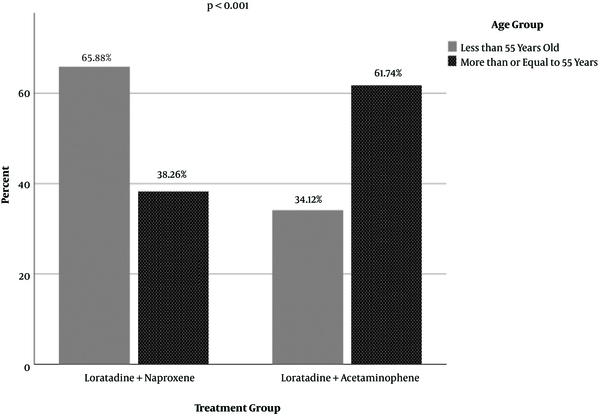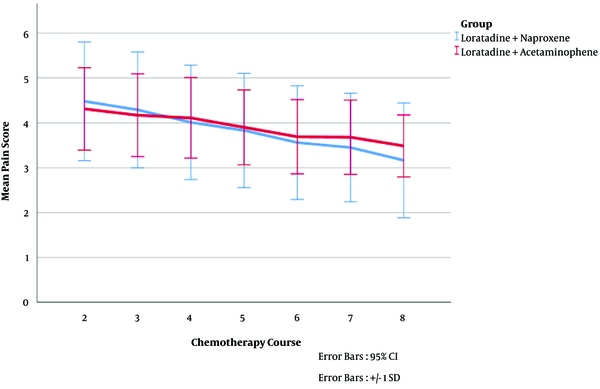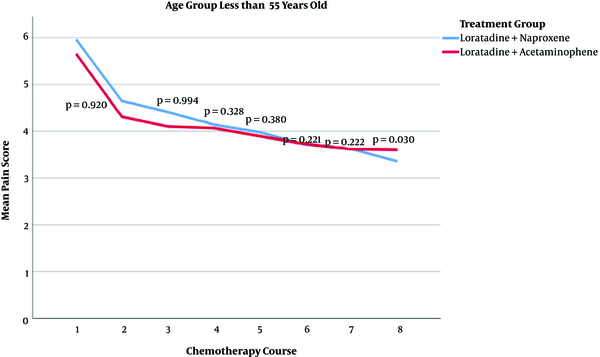1. Background
Neutropenia is one of the limiting side effects of cytotoxic chemotherapy drugs that can lead to life-threatening complications such as fever and neutropenia, leading to hospitalization and the need for intravenous antibiotics and mortality (1). Granulocyte-colony-stimulating factors (G-CSF), including Filgrastim and Pegfilgrastim, may be used as primary or secondary prevention to reduce the risk of fever and neutropenia in patients who receiving myeloid suppressive chemotherapy (2, 3). The use of G-CSF has helped clinicians maintain the dose intensity when using the various types of malignancy treatment protocols recommended by the American Clinical Oncology Association (4, 5). Pegfilgrastim is long-acting form, given as a 6 mg dose subcutaneously 24 to 72 hours after cytotoxic chemotherapy administration (6). One dose of Pegfilgrastim is recommended once per chemotherapy course (7). Pegfilgrastim is a relatively well-tolerated drug, but bone pain is the most common side effect associated with it (8, 9). Nonsteroidal anti-inflammatory drugs (NSAIDS), antihistamines, and opioids are used to treat this complication (10-12). Some of the complications of NSAIDs are the increased risk of acute renal failure and gastrointestinal complications, which are more common in people with a history of gastrointestinal complications, age older than 60 years, high doses of NSAIDs, and concomitant use of corticosteroids and anti-coagulants. Other complications include cardiac and hematologic complications (13).
Since most patients with cancer are elderly and have multiple underlying diseases such as hypertension, renal disease, and peptic ulcer, the use of a less complicated combination such as Acetaminophen and Loratadine, is better to control bone pain in these patients to avoid further complications. Although we do not have standard treatment for controlling the secondary pain to pegylated granulocyte colony stimulating factor (PEG G-CSF) following chemotherapy, but the combination of Naproxen and Loratadine is a combination that has been studied in several research and has had good results (14).
2. Objectives
The purpose of this study was to compare a less complicated combination with the well-known Naproxen and Loratadine combination and to conclude from the results that the treatment value of Acetaminophen and Loratadine is equivalent, better, or less than the combination of Naproxen and Loratadine.
3. Methods
This study was a phase III randomized clinical trial study. The patients with solid tumor and lymphoma patients who were candidates for PEG-G-CSF according to the well-known validated protocol of chemotherapy and referred to the oncology center of Imam Hossein Hospital for chemotherapy were randomly assigned to the study groups based on permuted block randomization list with block size of two. Patients were selected according to the inclusion criteria consisted of non-metastatic solid tumor patients and hematologic malignancies (lymphoma only, Hodgkin's, and non-Hodgkin's) who did not meet the exclusion criteria and according to standard chemotherapy protocol were candidates for PEG- G-CSF treatment.
The Ethics Committee of Shahid Beheshti University of Medical Sciences approved this study and the written informed consent form completed by patients. Exclusion criteria consisted of patients with bone metastasis, osteomalacia confirmed by laboratory tests, chronic kidney disease (CKD) or end-stage renal disease (ESRD), active rheumatologic disease, uncontrolled diabetes or thyroid disease, receiving chemotherapy agents that bone pains are one of their complications with a prevalence of over 10% (Taxon family, bisphosphonate, etc.) (15-17), pathologic fracture or fracture for any other reason, contraindication of naproxen use, vitamin D levels below 20 ng/mL, paget disease, hyperparathyroidism, score above 6 on the bone pain that achieved through questionnaire from the beginning of the study, liver disease, history of cardiac arrhythmia, and patients who did not have appropriate compliance to fill in the pain questionnaire.
The pain was scored based on the questionnaire before drug injection. Then, after the first course, patients received PEG-G-CSF (a specific brand covered by insurance) at a dose of 6 mg subcutaneously 24 hours after the end of chemotherapy. On the second day after receiving PEG-CSF, the patients were asked to complete a daily pain questionnaire according to the training that they received on the first visit, based on the increased amount of pain. Patients who have had at least 2 pain score increase after first to third course of chemotherapy, based on questionnaire scoring, were randomly entered in one of two treatment combination groups of “Acetaminophen 500 mg every 6 hours + Loratadine 10 mg daily” and “Naproxen 500 mg every 12 hours + Loratadine 10 mg daily” and the patients were asked to fill out a questionnaire based on pain numbers at a given hour daily and to inform the physician at a follow-up visit prior to next chemotherapy session. The evaluation period for each patient was until the end of the chemotherapy period. In the follow-up period, the side effects of medications were also evaluated. Patients who did not have pain relief at least 2 points after 3 courses of treatment were excluded from the study since the aim of this study was to investigate the effect of pain relief on one of those two medication combinations and failure to properly relieve pain (at least 2 pain reduction score in the course of treatment) can be due to the overall resistance of these patients to any treatment and may cause bias in the detection of the therapeutic effects of prescribed medications. High-intensity pain was likely to be due to other underlying causes that were not diagnosed by our initial screenings and reduce the comparative quality of the two medications. And if a study examines people whose risk is initially low or high for something, it causes bias. This reason attempted us to exclude people who may have other causes for their bone pain, which may reduce the accuracy of the study.
This study was not blinded. Independent t-test and chi-square tests were used for univariate analysis to compare study quantities between the two groups. The marginal model was used to compare the pain score between the two groups using the generalized estimation equations (GEE) method and the effect of age, baseline pain, and sex in the group was controlled. Interaction of group and other variables in the model was investigated and the only interaction about time and group was significant. Analyses were performed in SPSS version 25. The significance level was set at 0.05.
4. Results
A total of 100 (%50) women and 100 (%50) men were included in this study. The median age of the patients was 55.71 ± 11.84 years. The youngest and oldest patients were 25 and 78 years, respectively. Male to female sex ratio was 46 to 54 in group A and 54 to 46 in group B, respectively. There was no statistically significant difference in sex distribution between treatment groups (P = 0.258) (Figure 1).
The median age of the patients in the Naproxen treatment group was 52.63 ± 11.9 years and in the Acetaminophen treatment group was 58.8 ± 11 years. The median age of patients in the Acetaminophen group was significantly higher than the naproxen group (P < 0.001). Information on the age distribution of the groups is shown in Figure 2.
The mean pain score of the patients before chemotherapy was 1.07 in the Naproxen group and 1.67 in the Acetaminophen group. There was a statistically significant difference in the mean pain score between the two groups before the start of chemotherapy (P < 0.001). Details of patients' pain scores by treatment groups for before treatment with analgesic medication are shown in Table 1.
| Treatment Group | Score of Pain Before Treatment | Score of Pain in the First Week of Treatment | Score of Pain in the First Course of Chemotherapy |
|---|---|---|---|
| Loratadine + Naproxene | 0.624 ± 1.07 | 6.17 ± 1.17 | 1.34 ± 5.96 |
| Loratadine + Acetaminophene | 1.08 ± 1.67 | 1.13 ± 5.77 | 1.03 ± 5.48 |
| P value | < 0.001 | 0.014 | 0.008 |
Description and Comparison of Patients' Pain Score by Treatment Groups Before Starting Analgesicsa
To compare the effect of medication therapy on pain due to chemotherapy, because some patients received 8 courses and some 12 courses, the average pain of 8 to 12 courses was considered as the last course for patients who received 12 courses of chemotherapy. For patients who received 8 courses of chemotherapy, the 8th course was considered the last course. Patients' pain descriptions by treatment group are presented in Table 2.
| Chemotherapy Course, Treatment Group | Pain Mean Score | Standard Deviation | P Value |
|---|---|---|---|
| Second | 0.292 | ||
| Loratadine + Naproxene | 4.48 | 1.32 | |
| Loratadine + Acetaminophene | 4.31 | 0.918 | |
| Third | 0.450 | ||
| Loratadine + Naproxene | 4.29 | 1.30 | |
| Loratadine + Acetaminophene | 4.17 | 0.922 | |
| Forth | 0.522 | ||
| Loratadine + Naproxene | 4.01 | 1.28 | |
| Loratadine + Acetaminophene | 4.11 | 0.898 | |
| Fifth | 0.646 | ||
| Loratadine + Naproxene | 3.83 | 1.27 | |
| Loratadine + Acetaminophene | 3.90 | 0.835 | |
| Sixth | 0.391 | ||
| Loratadine + Naproxene | 3.56 | 1.27 | |
| Loratadine + Acetaminophene | 3.69 | 0.825 | |
| Seventh | 0.118 | ||
| Loratadine + Naproxene | 3.45 | 1.21 | |
| Loratadine + Acetaminophene | 3.68 | 0.827 | |
| Last | 0.028 | ||
| Loratadine + Naproxene | 3.16 | 1.28 | |
| Loratadine + Acetaminophene | 3.49 | 0.690 |
Description and Comparison of Patients' Pain in Chemotherapy Courses After Injection of Medication by the Treatment Group
When we included time as a ranked variable in the model, it was observed that the pain was decreasing during the chemotherapy courses, so that for each course that passed the chemotherapy, the mean pain was reduced by 0.320 units (P < 0.001). By controlling the effects of age, sex, and baseline pain, the mean pain in the second course in the Acetaminophen group was 0.280 units more than the Naproxen group (P = 0.044), the mean pain in the third course of chemotherapy in the Acetaminophen group was 0.330 units more than Naproxen group (P = 0.013), the mean pain of the patients in the fourth course of chemotherapy in Acetaminophen group was 0.550 units more than in Naproxen group (P < 0.001), the mean pain of the patients in the fifth course of chemotherapy in Acetaminophen group was 0.520 units more than in Naproxen group (P < 0.001), the mean pain score in the sixth course of chemotherapy in Acetaminophen group was 0.580 units more than in Naproxen group (P < 0.001), the mean pain of the patients in the seventh course of chemotherapy in the Acetaminophen group was 0.680 units more than in the Naproxen group (P < 0.001), and the mean pain in the last chemotherapy course in the Acetaminophen group was 0.772 units more than in the Naproxen group (P < 0.001) (Figure 3).
Analysis of the subgroup with less than 55 years with adjustment for baseline pain score showed that in all chemotherapy courses there was no significant difference between the pain scores of the treatment groups (P > 0.05 for courses 2 to 7) and only in the last course, the mean pain score of the patients receiving Acetaminophen was 0.552 units higher than patients receiving Naproxen (P = 0.030) (Figure 4). In analysis of the subgroup with over 55 years of age, to compare the pain score of the treatment groups with the moderation of baseline pain, it was found that the pain score of Acetaminophen patients was significantly higher than the Naproxen group. The results are shown in Figure 5.
5. Discussion
In this study, by controlling for the effects of age, sex, and baseline pain, in the second course of treatment onwards, Naproxen was significantly more effective than Acetaminophen in reducing pain.
The stratification was based on baseline pain but the baseline pain score was more in the Acetaminophen group. We adjusted this baseline unbalanced factor by the inclusion of baseline pain in the marginal model for the comparison of treatments on pain.
Pain is a subjective complaint. Different patients report different grades of pain, with the same event. We tried to make it objective by scaling. But anyway this may cause bias.
In a study of 100 patients with cancer, Nonsteroidal anti-inflammatory drugs (NSAIDs) were generally effective in relieving moderate pain, but severe pain was often refractory to all analgesia, including the provided narcotics (18), these results were consistent with our study. A clinical trial study was performed on 510 patients with cancer, in which the patients were given Naproxen 500 mg twice a day, with placebo for 5 to 8 days to improve G-CSF induced bone pain. Pain was assessed by a 0 - 10 scoring system and the effect of naproxen was demonstrated (19) and was consistent with our study. A study of 100 patients with ovarian cancer who received severe Naproxen and Oxycodone-resistant bone pain after receiving Pegfilgrastim showed that Loratadine reduced pain (20). In a study of bone pain caused by this drug in 120 patients with breast cancer who were resistant to Acetaminophen and Morphine, Antihistamine use was found to reduce pain (21). In a review article, a total of 3 randomized prospective studies and 2 retrospective studies evaluated pharmacological management of PEG-G-CSF induced bone pain. According to these studies, Naproxen was effective at managing prevention of pegfilgrastim-induced bone pain (PIBP). Although commonly used antihistamines had a paucity of data supporting their use (22), which is generally in line with our study.
In the present study, patients in the Acetaminophen group had more pain scores at the initiation of treatment. Therefore, this may result in less decrease in pain score in the Acetaminophen group with over 55 years old. This may be due to the higher average age of the Acetaminophen group that should be considered in future studies of this issue.
5.1. Conclusions
The median age of patients in the Acetaminophen group was significantly higher than the Naproxen group (P < 0.001). The mean pain score of patients before chemotherapy in the Naproxen group was 1.07 and in Acetaminophen group was 1.67. There was a statistically significant difference in the mean pain between the two groups before the start of chemotherapy (P < 0.001). By controlling for the effects of age, sex, and baseline pain, Naproxen had a significantly better performance of Acetaminophen in reducing pain, In the second course onwards, and the mean pain score in all courses was higher in the Acetaminophen group than in the Naproxen group (P = 0.044).
5.2. Suggestions
1. Perform the present study with the larger number of patients.
2. Use NSAIDs other than Naproxen or Antihistamines other than Loratadine to relieve pain.





